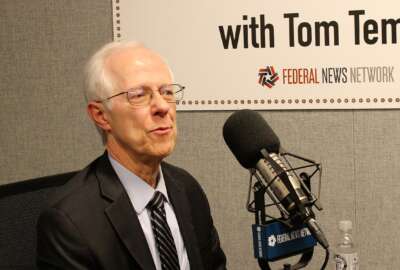What happens when a company that didn’t bid files an award protest?
A vendor of computer vision software protested a National Geospatial-Intelligence Agency award to systems integrator CACI.
In a long-running case, a vendor of computer vision software protested a National Geospatial-Intelligence Agency award to systems integrator CACI, which was going to develop its own computer vision software. The protester, Percipient, had not bid. But Percipient did file in the Court of Federal Claims on the basis that the government is obligated to use commercially available products. For what happened next, the Federal Drive with Tom Temin talked to Haynes and Boone procurement attorney Dan Ramish.
Interview Transcript:
Tom Temin: I guess before filing at the Court of Federal Claims, this company Percipient had gone back and forth with the NGA and with CACI, trying to get awarded as a subcontractor.
Dan Ramish: Yes, that’s right, Tom. So what’s interesting and unusual in this case is that Percipient wasn’t in a position to meet the government’s entire requirement. The government needed both a repository for storing and managing and disseminating visual intelligence and also the computer vision functions that Percipient provided. And so at most, it could act as a prospective subcontractor, but it couldn’t prime contract the work with the government. So it was relying on this statutory preference for using commercial products and services.
Tom Temin: So the question then when it went to the Court of Federal Claims after being said basically, ‘Thanks, but no thanks,’ by both NGA and CACI, it filed a protest on that basis. But there were two problems there right are two issues that had to overcome. 1. Did that really apply the commercial requirement and 2. Did the company have standing?
Dan Ramish: So there were both standing and jurisdictional questions as to whether the protests could survive. The government filed a motion to dismiss and the court actually dismissed because of what’s called the task order protest ban, which says that protests that are in connection with the issuance or proposed issuance of an order under an IDIQ contract can’t be protested to the Court of Federal Claims. There are dollar thresholds where you can bring a protest at GAO, but the court won’t hear protests of issuance or proposed issuance of orders. This was relating to an IDIQ contract.
Tom Temin: So that provision that they could not protest comes from the Federal Acquisition Streamlining Act that’s of long standing here.
Dan Ramish: That’s right. And so the court was actually willing to entertain at the trial level the idea that this company had standing to protest, but they said, ‘Oh, wait a minute, this is under a task order.’ And so the FASA task order protest bar applies.
Tom Temin: Alright. So what happened next?
Dan Ramish: So next, Percipient appealed to the Federal Circuit Court of Appeals. And on appeal, the two major issues were first, this FASA task order protest bar, whether Precipient’s protest was in connection with the issuance of proposed issuance of a task or delivery order, and then also whether Precipient had statutory standing to bring the protest when it wasn’t an actual or prospective bidder on the contract. Precipient admitted that they couldn’t meet the entire requirement.
Tom Temin: Right. So what did that court decide?
Dan Ramish: So this was a split decision Tom with a two-judge majority and one judge that was dissenting, and the majority found that the FASA task order protest bar did not apply and that Precipient was an interested party withstanding to protest under the specific facts of this case relating to the commercial products and services preference. So on the first issue, the FASA task order protest bar, the majority held the Percipient’s protest was not in connection with the issuance or proposed issuance of a task or delivery order. And Precipient’s complaint didn’t ask the court to set aside CACI’s task order. Instead, they were saying, ‘Hey, you government NDAA should require CACI to look at our product and use it under the task order, but they weren’t trying to invalidate or challenge the task order itself. So the majority was convinced by this argument that wasn’t relating to the issuance were proposed issuance of task order.
Tom Temin: Right, a fine line there, basically, that they drew.
Dan Ramish: Exactly. And the dissenting judge totally disagreed with that and said that it went against the court’s precedent in a case called SRA International that really broadly precluded all protests that relate to work performed under a task order, and that this in connection with language is very broad, whereas the majority said, ‘Hey, if there didn’t need to be an issuance or proposed issuance was being challenged, then those words would have no meaning in the statute.’ So there was a real disagreement between the majority and the dissent on that point.
Tom Temin: We’re speaking with Dan Ramish, a procurement attorney with Haynes Boone. So how does the thing stand at this point then?
Dan Ramish: So the second issue, the majority and the dissent also disagreed as far as standing. So only an interested party has standing to bring a protest and the term interested party is defined in the Competition in Contracting Act for GAO protests. But the comparative statute for the Court of Federal Claims doesn’t include a definition. And so there’s case law from the Federal Circuit that applies the GAO CICA standard to the Court of Federal Claims. But here, the majority looked at that standard and said, ‘It wasn’t really appropriate to apply under these circumstances because the protester was bringing a challenge that wouldn’t be viable under CICA. They were challenging a stand-alone violation of law or regulation without challenging a solicitation or an award or proposed award of a contract.
Tom Temin: Right. So CICA by the way is Competition in Contracting Act. So therefore, what’s the end result here for Precipient? Are they done here?
Dan Ramish: No. So the majority said it was appropriate to create a new, broader test specific to these circumstances. And they also looked at the particular statute for statutory preferences for commercial products and services and said, ‘Hey, under these circumstances, the prime contractor has no incentive to look seriously at subcontractors providing commercial products and services because the alternative often is that they’ll develop their own products.’
Tom Temin: That’s slow and expensive and lots of revenue.
Dan Ramish: Precisely. So a clear conflict of interest on the part of the prime contractor and the majority was persuaded by that and said, you know, ‘unless we have a standard here with a subcontractor can bring protests in these kinds of circumstances, the statutes never going to be given proper effect.’ And so the majority said, ‘We’re a plaintiff invoking only a challenge based on a violation of law without challenging the solicitation or a proposed award of a contract brings a specific challenge under the statutory preference for commercial products or services.’ There’ll be an interested party if there an offer of a commercial product or commercial service that had a substantial chance of being acquired to meet the needs of the agency if the violation hadn’t occurred. That’s a totally new test.
Tom Temin: So that requires then what on the part of the NGA and of CACI if anything at this point?
Dan Ramish: Well, so the majority reversed and remanded the trial court and so the next natural step is that it would go back to the Court of Federal Claims. There is a very real possibility that there will be further action at the Federal Circuit, however, with an en banc review, which means the government is likely to ask for the full appellate court to do a review of this decision and issue a new decision, particularly because the dissenting opinion here said that the majority was misapplying the court’s precedent. And so those are the kinds of circumstances where the full court might consider doing a review. But the dissent also points out, ‘Hey, if this stands, this is going to be a big deal.’ In the dissent’s words, a very important government contracts case. And the dissent was pointing out, ‘Hey, this could lead to a flood of subcontractor protests that the government didn’t properly consider commercial products or services.’
Tom Temin: Every time the government then contracts for development of software, somebody somewhere could say, ‘Wait, I already do that function with my commercial software.’ And it can open a floodgate, basically, is what they’re worried about.
Dan Ramish: Commercial software, professional services, widgets across the board. The dissent is envisioning a new world where every company that offers a commercial product or service, watching the government develop something new or do its own thing without properly considering commercial alternatives could bring a lawsuit. The Court of Federal Claims using this new test.
Tom Temin: So at this point, though, the case is remanded to the Court of Federal Claims, which has to reconsider it basically.
Dan Ramish: Yes, they have to proceed with the protest. But as we say, I think this will be subject to further litigation. But it should stand unless it is overturned en bonk by the full appellate court.
Copyright © 2025 Federal News Network. All rights reserved. This website is not intended for users located within the European Economic Area.
Tom Temin is host of the Federal Drive and has been providing insight on federal technology and management issues for more than 30 years.
Follow @tteminWFED






